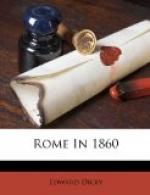CHAPTER XVIII. TWO PICTURES.
Within the space of a few days, some three weeks in all, it was my fortune to be present at two demonstrations forming two pictures of Italian story, or rather two aspects of one picture. In both the subject-matter was the feelings of Italians towards their rulers; in both that feeling was expressed legibly, though in diverse fashions; and from both one and the same lesson—that lesson, which I have sought to express in these loose sketches of mine—may be learned easily. Let me first, then, write of these pictures as I saw them at the time, so that my moral may speak for itself to those who care to learn it.
The 12th of April is the anniversary of Pio Nono’s return to Rome from Gaeta, that refuge of destitute sovereigns. It is also, by a strange coincidence, the anniversary of the day on which his Holiness and General Goyon narrowly escaped being killed by the falling of a scaffold, from which they were inspecting the repairs at the church of St Agnese. On that day, in honour of the doubly joyful event, the Pope went to celebrate mass at the convent of St Agnese. The time was one when a popular demonstration in favour of the Pope was urgently required. It was in fact the beginning of the end. Victor Emmanuel was about to enter Bologna as king; the news of the Sicilian insurrection had just reached Rome; the Imperial Government had sent one of its periodical intimations, that the French occupation could not be prolonged indefinitely; and General De La Moriciere had assumed the command of the Papal army, on his ill-fated and Quixotic crusade. At such a time it was deemed necessary to show Europe, that the Pope still reigned in the hearts of his people, and every effort was made to secure a demonstration. Government clerks and official personages received orders to be present at the ceremony; and all persons, over whom the Priests had influence, were urged to attend and swell the crowd. And yet what came of it all? Along the road between the Convent of Santa Agnese and the Porta Pia, where the great demonstrations took place some weeks ago, there was little sign of crowd or excitement. The day was chilly and cheerless; but the chilliness of the wind itself precluded the idea of rain, so that it was not the weather which deterred the concourse of the faithful. The Patrizzi Villa, just outside the gate, had a few festoons hung over the garden wall, which fronts the road; but one of the Patrizzi family, I should mention, is a Cardinal. The villas on the road exhibited no decorations or signs of festivity whatever. Indeed, I only observed three houses in all which had placed hangings before their windows, or made any preparations in honour of the event. There were not many persons outside the gates. Every few steps you met patrols of six French soldiers headed by a gendarme. These patrols had been sent by General Goyon to keep the




